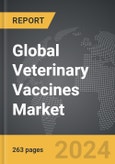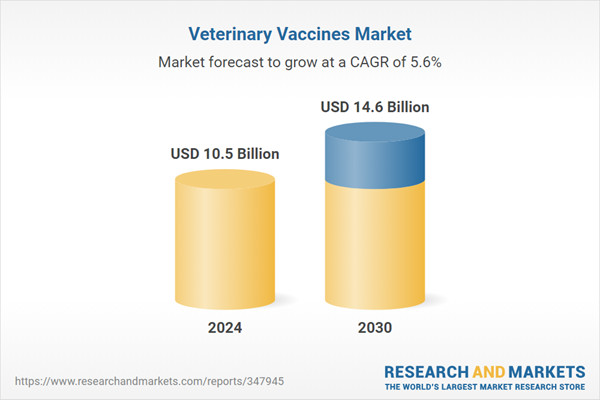The global market for Veterinary Vaccines was valued at US$10.5 Billion in 2024 and is projected to reach US$14.6 Billion by 2030, growing at a CAGR of 5.6% from 2024 to 2030. This comprehensive report provides an in-depth analysis of market trends, drivers, and forecasts, helping you make informed business decisions. The report includes the most recent global tariff developments and how they impact the Veterinary Vaccines market.
Segments: Type (Porcine Vaccines, Poultry Vaccines, Canine Vaccines, Bovine Vaccines, Feline Vaccines, Ovine Vaccines, Other Types); Technology (Inactivated Vaccines, Live Attenuated Vaccines, Recombinant Vaccines, Toxoid Vaccines, Other Vaccines).
Geographic Regions/Countries: World; United States; Canada; Japan; China; Europe (France; Germany; Italy; United Kingdom; and Rest of Europe); Asia-Pacific; Rest of World.
The analysts continuously track trade developments worldwide, drawing insights from leading global economists and over 200 industry and policy institutions, including think tanks, trade organizations, and national economic advisory bodies. This intelligence is integrated into forecasting models to provide timely, data-driven analysis of emerging risks and opportunities.
Global Veterinary Vaccines Market - Key Trends and Drivers Summarized
Why Are Veterinary Vaccines Crucial for Animal Health?
Veterinary vaccines are essential tools in safeguarding animal health, preventing the spread of infectious diseases, and promoting overall well-being in livestock, pets, and wildlife. These vaccines work by stimulating the animal's immune system to recognize and combat specific pathogens, reducing the incidence of diseases such as rabies, distemper, parvovirus, and avian influenza. For livestock, vaccinations are critical in ensuring the health of herds and flocks, thereby protecting food supply chains and minimizing economic losses for farmers. In companion animals, vaccines help maintain the health of pets, preventing potentially deadly diseases and reducing the risk of zoonotic infections that can be transmitted to humans. By controlling disease outbreaks, veterinary vaccines play a vital role in public health, food security, and the humane treatment of animals.Not Just Animals, How Veterinary Vaccines Protect Us from Zoonotic Diseases?
Veterinary vaccines play a crucial role in reducing the risk of zoonotic diseases, which are infections transmitted from animals to humans. By immunizing animals, these vaccines prevent the initial establishment and subsequent spread of infectious agents among animal populations, thereby acting as a critical barrier against the transmission to humans. For instance, rabies vaccines administered to wildlife and domestic pets have significantly decreased the incidence of this fatal disease in humans. Similarly, vaccinating livestock against diseases like brucellosis and anthrax, which can be transmitted through direct contact or by consuming contaminated animal products, protects human health and enhances food safety. Furthermore, by controlling these diseases in animal populations, veterinary vaccines reduce the environmental load of pathogens, lowering the chance of human exposure and potential outbreaks. This proactive approach not only safeguards public health but also supports the welfare of domestic and wild animal populations, illustrating the intertwined health of humans and animals within shared ecosystems.How Are Technological Advances Shaping Veterinary Vaccines?
Technological advancements are revolutionizing the field of veterinary vaccines, making them more effective, safer, and easier to administer. Innovations such as recombinant DNA technology and vector-based vaccines have enabled the development of vaccines that offer broader protection and longer-lasting immunity. For instance, subunit vaccines, which include only parts of the pathogen, reduce the risk of adverse reactions while still providing robust immunity. Additionally, advances in adjuvants - substances that enhance the immune response - are improving the efficacy of vaccines, especially in species that are difficult to immunize. Another significant development is the advent of oral and intranasal vaccines, which simplify administration, particularly in large-scale livestock operations. These innovations are not only enhancing the health and productivity of animals but also ensuring more sustainable and efficient agricultural practices.What Challenges and Trends Are Impacting the Veterinary Vaccine Industry?
The veterinary vaccine industry faces several challenges, including the constant evolution of pathogens and the need for vaccines that can address multiple strains. The emergence of antibiotic-resistant bacteria underscores the importance of vaccines in reducing reliance on antibiotics, thereby mitigating the risk of resistance. Regulatory hurdles also pose significant challenges, as vaccines must undergo rigorous testing to ensure safety and efficacy, which can be time-consuming and costly. Despite these challenges, there are promising trends shaping the industry. There is a growing emphasis on developing vaccines for emerging diseases, supported by advances in genomics and bioinformatics that allow for rapid identification of pathogen targets. Additionally, the integration of big data and artificial intelligence is streamlining vaccine development processes and improving disease surveillance, enabling more proactive and targeted vaccination strategies.What Drives the Growth in the Veterinary Vaccines Market?
The growth in the veterinary vaccines market is driven by several factors, including increasing pet ownership and the rising demand for animal-derived food products. As more people consider pets part of their family, there is a greater willingness to invest in preventive healthcare, including vaccinations. In the agricultural sector, the intensification of livestock farming and the need to ensure food safety and security drive the demand for effective vaccines to prevent disease outbreaks. Technological advancements that lead to the development of more effective and convenient vaccines also contribute to market expansion. Moreover, heightened awareness of zoonotic diseases and the role of veterinary vaccines in preventing these infections promote the adoption of vaccination programs. Regulatory support and initiatives to control and eradicate animal diseases further stimulate market growth, ensuring that veterinary vaccines remain a critical component of animal healthcare and public health initiatives.Report Scope
The report analyzes the Veterinary Vaccines market, presented in terms of units. The analysis covers the key segments and geographic regions outlined below.Segments: Type (Porcine Vaccines, Poultry Vaccines, Canine Vaccines, Bovine Vaccines, Feline Vaccines, Ovine Vaccines, Other Types); Technology (Inactivated Vaccines, Live Attenuated Vaccines, Recombinant Vaccines, Toxoid Vaccines, Other Vaccines).
Geographic Regions/Countries: World; United States; Canada; Japan; China; Europe (France; Germany; Italy; United Kingdom; and Rest of Europe); Asia-Pacific; Rest of World.
Key Insights:
- Market Growth: Understand the significant growth trajectory of the Porcine Vaccines segment, which is expected to reach US$4.7 Billion by 2030 with a CAGR of a 6.6%. The Poultry Vaccines segment is also set to grow at 5.8% CAGR over the analysis period.
- Regional Analysis: Gain insights into the U.S. market, valued at $2.8 Billion in 2024, and China, forecasted to grow at an impressive 5.3% CAGR to reach $2.3 Billion by 2030. Discover growth trends in other key regions, including Japan, Canada, Germany, and the Asia-Pacific.
Why You Should Buy This Report:
- Detailed Market Analysis: Access a thorough analysis of the Global Veterinary Vaccines Market, covering all major geographic regions and market segments.
- Competitive Insights: Get an overview of the competitive landscape, including the market presence of major players across different geographies.
- Future Trends and Drivers: Understand the key trends and drivers shaping the future of the Global Veterinary Vaccines Market.
- Actionable Insights: Benefit from actionable insights that can help you identify new revenue opportunities and make strategic business decisions.
Key Questions Answered:
- How is the Global Veterinary Vaccines Market expected to evolve by 2030?
- What are the main drivers and restraints affecting the market?
- Which market segments will grow the most over the forecast period?
- How will market shares for different regions and segments change by 2030?
- Who are the leading players in the market, and what are their prospects?
Report Features:
- Comprehensive Market Data: Independent analysis of annual sales and market forecasts in US$ Million from 2024 to 2030.
- In-Depth Regional Analysis: Detailed insights into key markets, including the U.S., China, Japan, Canada, Europe, Asia-Pacific, Latin America, Middle East, and Africa.
- Company Profiles: Coverage of players such as Bayer de México SA de CV, Biogénesis Bagó SA, Boehringer Ingelheim International GmbH, Ceva Santé Animale, Elanco Animal Health and more.
- Complimentary Updates: Receive free report updates for one year to keep you informed of the latest market developments.
Some of the 22 companies featured in this Veterinary Vaccines market report include:
- Bayer de México SA de CV
- Biogénesis Bagó SA
- Boehringer Ingelheim International GmbH
- Ceva Santé Animale
- Elanco Animal Health
- Heska Corporation
- Indian Immunologicals Ltd.
- Merck Animal Health
- Virbac SA
- Zoetis Inc.
Tariff Impact Analysis: Key Insights for 2025
Global tariff negotiations across 180+ countries are reshaping supply chains, costs, and competitiveness. This report reflects the latest developments as of April 2025 and incorporates forward-looking insights into the market outlook.The analysts continuously track trade developments worldwide, drawing insights from leading global economists and over 200 industry and policy institutions, including think tanks, trade organizations, and national economic advisory bodies. This intelligence is integrated into forecasting models to provide timely, data-driven analysis of emerging risks and opportunities.
What’s Included in This Edition:
- Tariff-adjusted market forecasts by region and segment
- Analysis of cost and supply chain implications by sourcing and trade exposure
- Strategic insights into geographic shifts
Buyers receive a free July 2025 update with:
- Finalized tariff impacts and new trade agreement effects
- Updated projections reflecting global sourcing and cost shifts
- Expanded country-specific coverage across the industry
Table of Contents
I. METHODOLOGYII. EXECUTIVE SUMMARY2. FOCUS ON SELECT PLAYERSIII. MARKET ANALYSISREST OF WORLDIV. COMPETITION
1. MARKET OVERVIEW
3. MARKET TRENDS & DRIVERS
4. GLOBAL MARKET PERSPECTIVE
UNITED STATES
CANADA
JAPAN
CHINA
EUROPE
FRANCE
GERMANY
ITALY
UNITED KINGDOM
REST OF EUROPE
ASIA-PACIFIC
Companies Mentioned (Partial List)
A selection of companies mentioned in this report includes, but is not limited to:
- Bayer de México SA de CV
- Biogénesis Bagó SA
- Boehringer Ingelheim International GmbH
- Ceva Santé Animale
- Elanco Animal Health
- Heska Corporation
- Indian Immunologicals Ltd.
- Merck Animal Health
- Virbac SA
- Zoetis Inc.
Table Information
| Report Attribute | Details |
|---|---|
| No. of Pages | 263 |
| Published | April 2025 |
| Forecast Period | 2024 - 2030 |
| Estimated Market Value ( USD | $ 10.5 Billion |
| Forecasted Market Value ( USD | $ 14.6 Billion |
| Compound Annual Growth Rate | 5.6% |
| Regions Covered | Global |









